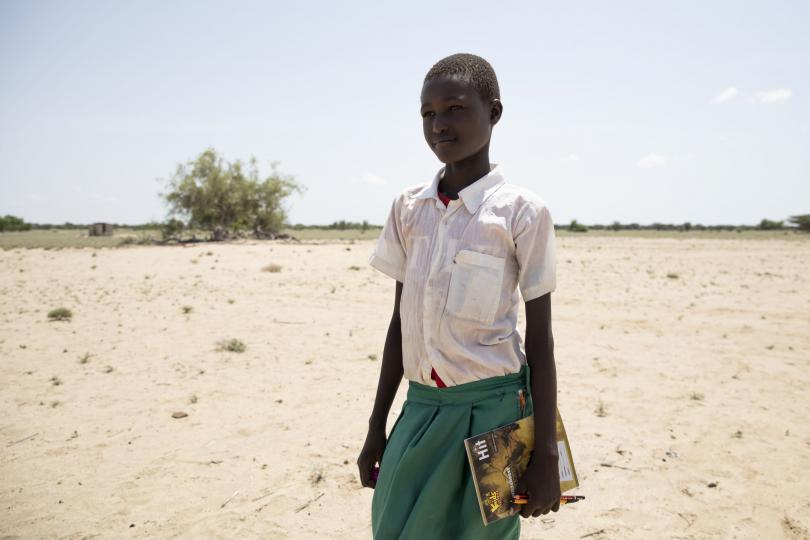What did 13,000 children in 46 countries tell us about living through COVID-19?

Harriet*, 14, at her home in Bidi Bidi Refugee settlement in Northern Uganda
The world is certainly not lacking in research on COVID-19. But there have been gaps in empirical data showing the lived experience of people around the world. Today, Save the Children is filling some of those gaps with the release of findings from an unprecedented study, asking over 13,000 children and 31,000 caregivers in 46 countries about how COVID-19 has impacted on a range of aspects of their lives.
The findings, taken one by one, often confirm what we have come to expect – incomes losses, impact of school closures, increased violence in the home – even if the scale retains the capacity to shock. But here are three issues that stand out:
First is the mixture of universality and difference in impacts. We can all relate to issues around fear of infection, quality of distance learning and contact with friends, whether we’re from the UK, US, Paraguay, Burkina Faso or Nepal.
“[I would tell other children] that they have to be strong to face the disease, not to be afraid because it lowers our defences and that we have to be in good spirits despite the circumstances of the moment we are living” – Girl, 15 years old, Peru

Leonara*, 13, a Venezuelan migrant living in Peru, packing her books for school in 2019
Alongside some universal experiences, though, there are major differences when you probe issues of disability, gender, location, migration and socio-economic status. The findings relating to disability in particular shed new light. We have learned, for example, that many more children from households where the parent or caregiver had a disability reported violence in the home, compared to those households where parents or caregivers did not have a disability (31% vs 16%).
Caregivers of children with disabilities were significantly more likely to report not being able to access needed counselling and mental health services than caregivers of children without disabilities, and children with disabilities were less likely to have accessed learning materials like remote learning and textbooks or reading books. Policy and programming responses need to be more tailored to such differences.
Second is the centrality of getting the return to school right, not just for learning but also for wellbeing and protection from violence. School closures have been an almost universal feature of the response to COVID-19. 80% of children themselves feel they have learned little or nothing since lockdowns began.
Simply providing distance learning opportunities is not enough – though that is more than many children receive. Children tell us the greatest barrier to learning is not having someone who can help them with their work and answer their questions. Worse, we found a clear relationship between school closures – and indeed the duration of school closure – and levels of violence in the home.
Conversely, children whose schools were open showed significantly better mental wellbeing than those whose schools were closed. Children who had contact with their friends were roughly ten times less likely to report feeling less happy, more worried and less safe than before COVID-19 than children who didn’t have personal and virtual contact with friends. Encouragingly, 95% of the children we surveyed said they believe they will return to school once it reopens, with similar responses for girls and boys.

Zipporah, 12, a third grade student, walking to school in Turkana, Kenya, in 2018
The third issue is the importance of listening to and involving children to ensure policy-making really is in the best interests of children. As we’ve come to expect from a generation showing such leadership and activism on climate change, there is no shortage of insight, capacity and appetite among children to influence responses to COVID-19.
Our survey elicited over 50,000 open-ended responses to questions such as what messages children would send to their governments and to other children. Amidst the gloomy statistics, children show extraordinary resilience and determination. Their top priorities for their leaders came out as safe return to school and supporting families to cope better with income loss.
“Please pay closer attention to the children. Throughout this time, we’ve only heard about the COVID-19 rules, and they’ve only increased panic. They were also only dealing with political issues. No one bothered about our mental and physical health.” – Girl, 14 years-old, Kosovo

A Save the Children staff member helping a child wear his mask in Mathare slum, Kenya
While we found children were generally well informed about COVID-19, less than half told us they were listened to when talking to their family about COVID-19 and only one third said their opinion was asked. Interestingly, we found statistically significant correlations between those children who felt listened to and those expressing lower levels of worry and higher levels of safety.
So there’s a double-win to be had from involving children more: both getting more appropriate action on COVID-19 and strengthening children’s own mental health.
“There is a huge leisure hour and I am getting more time to spend with my family members. But the greatest thing about covid-19 is the time of crisis is not only giving us the time to connect with our dear ones but also giving us the ability to reconnect with our passion.” – Girl, 16 years old, Bangladesh
These insights from children are causing us in Save the Children to revise priorities and adapt our responses. It is essential that children themselves – and particularly those from more marginalised communities – are given a greater voice in broader COVID-19 policy responses, as is their right. We hope the findings from this study will go some way to demonstrating both the potential to engage children and the value-add of doing so.
Please refer to our Global Research Series and flagship Protect A Generation report to find out more on the Hidden Impact of COVID-19 on Children.







